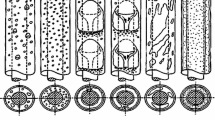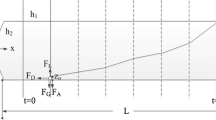Abstract
The hydrate formation or dissociation in deep subsea flow lines is a challenging problem in oil and gas transport systems. The study of multiphase flows is complex while necessary due to the phase changes (i.e., liquid, solid, and gas) that occur with increasing the temperature and decreasing the pressure. A one-dimensional multiphase flow model coupled with a transient hydrate kinetic model is developed to study the characteristics of the multiphase flows for the hydrates formed by the phase changes in the pipes. The multiphase flow model is derived from a multi-fluid model, while has been widely used in modelling multiphase flows. The heat convection between the fluid and the ambient through the pipe wall is considered in the energy balance equation. The developed multiphase flow model is used to simulate the procedure of the hydrate transport. The results show that the formation of the hydrates can cause hold-up oscillations of water and gas.
Similar content being viewed by others
Abbreviations
- A k :
-
pipe cross sectional area of phase k, m2
- A p :
-
pipe cross sectional area, m2
- A wall :
-
surface area of the pipe, m2
- a ig :
-
interfacial area concentration, m−1
- C dg :
-
drag coefficient
- C p :
-
average heat capacity, J·kg−1·K−1
- d :
-
pipe diameter, m
- H k :
-
hold-up of phase k
- i :
-
node index for the spacial discretization
- F :
-
internal force
- Q k :
-
volumetric flow rate of phase k, m3·s−1
- q :
-
pipe wall heat flux, J·m−2·s−1·kg−1
- Re g :
-
bubble Reynolds
- t :
-
time, s
- T :
-
fluid temperature, K
- T 0 :
-
ambient temperature, K
- S e :
-
energy generation per unit volume related to exothermic hydrate reaction, J·kg−1·s−1
- U 0 :
-
overall heat transfer coefficient, J·m−2·s−1·kg−1
- U k :
-
velocity of phase k, m·s−1
- U m :
-
mixture velocity, m·s−1
- U s :
-
slip velocity, m·s−1
- U sk :
-
superficial velocity of phase k, m·s−1
- v :
-
volume average velocity, m·s−1
- x :
-
axial coordinate along the pipe length, m
- ρ k :
-
density of each phase k, kg·m−3
- ϕ hyd :
-
hydrate formation rate per unit volume, kg·m−3·s−1
- ϕ w :
-
mass transfer rate of water per unit volume, kg·m−3·s−1
References
Sloan, E. D. Clathrate Hydrates of Natural Gases, Marcel Dekker Inc., New York (1998)
Burshears, M., O’Brien, T., and Malone, R. A multi-phase, multi-dimensional, variable composition simulation of gas production from a conventional gas reservoir in contact with hydrates. SPE Journal, 1546, 449–453 (1986)
Makogon, Y. F. Hydrate of Hydrocarbons, PennWell Publishing Co., Tulsa, Oklahoma (1997)
Clarke, M. and Bishnoi, P. R. Determination of the intrinsic rate constant of ethane gas hydrate decomposition. Chemical Engineering Science, 55, 4869–4883 (2000)
Clarke, M. and Bishnoi, P. R. Determination of the activation energy and intrinsic rate constant of methane gas hydrate decomposition. The Canadian Journal of Chemical Engineering, 79, 143–147 (2001)
Kim, H. C., Bishnoi, P. R., Heidemann, R. A., and Rizvi, S. S. H. Kinetics of methane hydrate decomposition. Chemical Engineering Science, 42, 1645–1653 (1987)
Sun, X. F. and Kishore, K. M. Kinetic simulation of methane hydrate formation and dissociation in porous media. Chemical Engineering Science, 61, 3476–3495 (2006)
Carroll, J. Nature Gas Hydrates: A Guide for Engineers, Gulf Publishing, Tulsa (2002)
Cree, L. J. L. and Subramanian, S. New methods for managing hydrates in deepwater tiebacks. Proceedings of the Offshore Technology Conference, Huston, Texas (2011)
Denielson, T. J. A simple model for hydrodynamic slug flow. Proceedings of the Offshore Technology Conference, Huston, Texas (2011)
Zerpa, L. E., Ishan, R., Aman, Z. M., Danielson, T. J., Koh, C. A., Sloan, E. D., and Sum, A. K. Multiphase flow modeling of gas hydrates with a simple hydrodynamic slug flow model. Chemical Engineering Science, 99, 298–304 (2013)
Turner, D. J. Clathrate Hydrate Formation in Water-in-Oil Dispersion, Ph.D. dissertation, Colorado School of Mines, Colorado (2005)
Yuan, Y. R., Zhao, W. D., Cheng, A. J., and Han, Y. J. Simulation and application of three-dimensional migration-accumulation of oil resources. Applied Mathematics and Mechanics (English Edition), 20(9), 999–1000 (1999) DOI 10.1007/BF02459063
Natsuo, H., Hitoshi, F., and Makoto, I. Theoretical analysis of flow characteristics of multiphase mixtures in a vertical pipe. International Journal of Multiphase Flow, 24, 539–561 (1998)
Chaudhary, R. C. and Abhay, K. J. Effects of chemic reactions on MHD micropolar fluid flow past a vertical plate in slip-flow regime. Applied Mathematics and Mechanics (English Edition), 29(9), 1179–1194 (2008) DOI 10.1007/s10483-008-0907-x
Ishii, M., Mishima, K., Kataoka, I., and Kocamustafaogullarim, G. Two-fluid model and importance of the interfacial area in two-phase flow analysis. Proceedings of 9th U.S. National Congress of Applied Mechanics, Ithaca, New York, 73–80 (1982)
Kurul, N., and Podowski, M. Z. On the modelling of multidimensional effects in boiling channels. Proceedings of the 27th National Heat Transfer Conference, Minneapolis (1991)
Kocamustafaogullari, G., Huang, W. D., and Razi, J. Measurement and modelling of average void fraction, bubble size and interfacial area. Nuclear Engineering and Design, 48, 437–453 (1994)
Tomiyama, A., Kataoka, I., and Sakaguchi, T. Drag coefficient of bubbles-1st report, drag coefficient of a single bubble in a stagnant liquid. Transactions of the Japan Society of Mechanical Engineers, Part B, 61, 2357–2364 (1995)
Tomiyama, A., Kataoka, I., Fukuda, T., and Sakaguchi, T. Drag coefficient of bubbles-2nd report, drag coefficient of a swarm of bubbles in and its applicability to transient flow. Transactions of the Japan Society of Mechanical Engineers, Part C, 61, 2810–2817 (1995)
Lahey, R. T., Cheng, L. Y., Drew, D. A., and Flaherty, J. E. The effect of virtual mass on the numerical stability of accelerating two-phase flows. International Journal of Multiphase Flow, 6, 281–294 (1980)
Cazarez-Candia, O. and Vasquez-Cruz, M. A. Prediction of pressure, temperature and velocity distribution of two-phase flow in oil wells. Journal of Petroleum Science and Engineering, 46, 195–208 (2005)
Bai, Y. and Bai, Q. Heat transfer and thermal insulation. Subsea Piplelines and Risers-Part III: Flow Assurance, Elsevier, 317–356 (2005)
Boxall, J., Davies, S., Koh, C. A., and Sloan, E. D. Predicting when and where hydrate plugs form in oil-dominated flowlines. SPE Projects Facilities and Construction, 4, 80–86 (2009)
Biberg, D. An explicit approximation for the wetted angle in two-phase stratified pipe flow. The Canadian Journal of Chemical Engineering, 77, 1221–1224 (1999)
Author information
Authors and Affiliations
Corresponding author
Additional information
Project supported by the National Natural Science Foundation of China (Nos. 11272198 and 11572183)
Rights and permissions
About this article
Cite this article
Tang, S., Liu, C. & Dong, Y. Multiphase flow model developed for simulating gas hydrate transport in horizontal pipe. Appl. Math. Mech.-Engl. Ed. 37, 1193–1202 (2016). https://doi.org/10.1007/s10483-016-2127-6
Received:
Revised:
Published:
Issue Date:
DOI: https://doi.org/10.1007/s10483-016-2127-6




